Biology
- Prokaryotes Vs Eukaryotes
While eukaryotic cells and prokaryotic cells have some characteristics in common, they diverged from their common ancestor billions of years ago, thus accounting for significant differences in overall structure and function. Here we will go over them....
- Eukaryotic And Prokaryotic Cells
What are Eukaryotic and Prokaryotic cells??? They are the tiny little building blocks of life and sometimes death! Eukaryotic cells are what make up humans, animals, and plants. They do everything from constructing us as babies with DNA to making...
- Cellulose
The cells of a plant are surrounded by a thick protective layer called the cell wall. Cellulose is a major component of this protective layer. Cellulose is a polysaccharide, a polymer of glucose, (carbohydrate) and it is the most abundant macromolecule...
- #2.1. Cell Structure - Syllabus 2015
? The microscope in cell studies ? Cells as the basic units of living organisms ? Detailed structure of typical animal and plant cells, as seen using the electron microscope ? Outline functions of organelles in plant and animal cells ? Characteristics...
- Some Living Descriptions
Protista- unicellular eukaryotes, some multicelled formscell sturcture simple to very complexsome heterotrophs- protozoanssome autotrophs- algaeasexual repro, some both sexual, asexualmotile, non-motile, sizes- most microscopic but some may be 100m in...
Biology
It?s A Plant World, We?re Just Living In It
Biology concepts ? cell walls, chloroplasts, myco-heterotrophs, holoparasites,
Life on Earth is easy. It can be boiled down to three sentences. ?The mitochondria and the chloroplasts are, in a fundamental sense, the most important things on Earth. Between them, they produce oxygen and arrange for its use. In effect, they run the place.? Lewis Thomas wrote this in his award winning book, The Lives Of The Cell: Notes Of A Biology Watcher, in 1975.
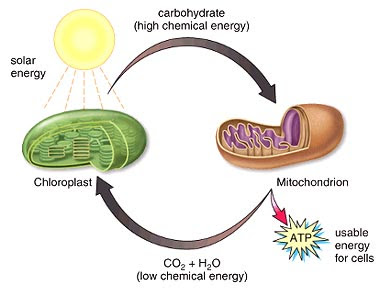 |
Nature?s carbon recycling center. The sun?s energy is used to polymerize carbon (CO2) into carbohydrates (CHO) and releases oxygen (O2). Then the mitochondria use the O2 to break down the CHO, resulting in chemical energy (ATP) and carbons (CO2) ready to be polymerized again. |
He was so right - for the organisms that use them - I guess he didn't consider the exceptions. These two organelles mesh seamlessly in their functions. One produces carbohydrate and oxygen, while consuming carbon dioxide. The other consumes carbohydrate and oxygen and produces carbon dioxide. The ultimate recyclers.
If these two organelles are the most important things for life, then doesn?t that make plants the kings of life on Earth, since they have both chloroplasts and mitochondria? Makes you feel a bit more humble now about your place in world, doesn't it.
However, this brings up an essential question ? and the main focus of today?s topic and exceptions. What makes a plant cell a plant cell? Green algae have chloroplasts and mitochondria, but they aren?t plants, they belong to the kingdom Protista. We have discussed the sea slug, E. chlorotica, and its ability to photosynthesize ? it is certainly not a plant. So what makes a cell a plant cell?
Leaving the chloroplast out of the equation for a minute, you could argue that a plant cell is one with a cell wall and cell membrane. That surely separates them from animal cells, since animal cells only have the cell membrane. But many bacteria, archaea, fungi, and algae have cell walls. If the argument is refined to define a plant as having a certain kind of cell wall, then we must look a little closer. Many cell walls are made of sugars, but are plant cell walls unique in their constituents?
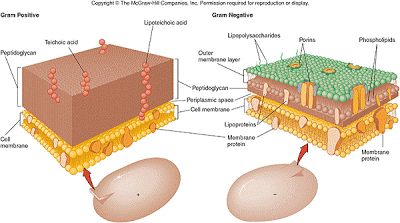 |
True bacteria have two large groupings, Gram+ and Gram -, based on their cell wall structures. The gram stain sticks to the peptidoglycan layer, so the thick layer on G+ bacteria make them stain deeply. The lipopolysaccharide (LPS) layer of the G- species keeps them from staining, and is highly toxic. Endotoxin (LPS) and causes about 70% of septic shock cases. |
Bacteria cell walls are made of peptioglycan (peptido = amino acid containing, and glycan = polymer of two sugars). One of the two components is always N-acetylmuramic acid, and the other is often poly-N-acetylglucosamine, but other things can be included as well. The exception is the Mycoplasma, a group of small bacteria that don?t have a cell wall at all. Since many antibiotics function by disabling the bacterial cell wall or preventing its formation, they don?t work against mycoplasma infections like M. genitalium, which a 2011 study linked to pelvic inflammatory disease in women.
Fungal cell walls are also made of a polysaccharide (poly = many, and saccharide = sugar), in a polymer called chitin. Chitin is also the rigid polymer that makes so many insects crunch when you step on them. Chitin cell walls are defining for fungi, as many cellulose containing cell wall fungi have been moved out of the kingdom of Fungi. But this still doesn?t tell us what is unique to plant cell walls.
Plant cell walls contain cellulose, and is complex. Plant cell walls can contain up to three layers, with different sugars involved, including cellulose, hemicellulose, and pectin, and lignin. Lignin is a more rigid polysaccharide that gives strength. It is what makes bark hard, protective, and water resistant.
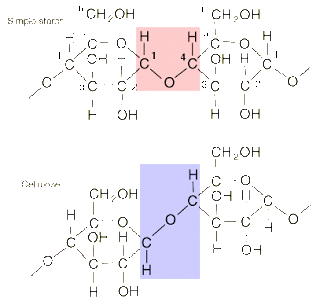 |
If the hydrogens (H) bound to the #1 and #4 carbons up on the same side, the polymer is starch. If they are on different sides, the polymer is cellulose. We can digest starch: we can?t digest cellulose. Plants make both ? the part we can?t digest we call dietary fiber. |
Celluloseis made of a chain of glucoses, yet we can?t digest it. The number one carbon in glucose has an ?H that is sticking up or down. If the ?H sticks ?down?, then it is an alpha glucose. If it sticks ?up?, then it is a beta-glucose. Cellulose is linked chains of beta-glucose. Starch is linked chains and branches of alpha-glucose. Just that difference in ?H position determines if it is food for us or not. Herbivores have the enzymes (and bacteria) to digest cellulose, but not us.
So is it the inclusion of cellulose that makes a plant cell wall unique? Well, no. Algal cells also use cellulose in their cell walls. You might try to argue that algae are plants, since many of them also have chloroplasts and are primary producers ? but you would be wrong. Algae can be unicellular (although they can also be multicellular) while plants are all multicellular. Algae don?t have specialized reproductive cells or parts like plants do; algae reproduce by spore or from broken parts of themselves. Finally, DNA analysis shows that while plants and algae are monophyletic(one ancestor), they diverged from one another long ago.
Then there is the issue that not every plant cell has a cell wall. In angiosperms (angio = chest or vessel, and sperm = seed; plants with enclosed seeds and flowers), the gamete (sex) cells of the male in the pollen and the gamete cells of the female in the ovary do not have cell walls, at least not on all sides. The ovary contains the ovules (latin for small egg), and the pollen contains the sperm cells and the tube cell, that forms the pollen tube and delivers the sperms cells to the ovules.
After the ovules are fertilized by the sperm cells of the pollen, the ovules form the seeds, and the ovary forms the fruit. From here on in, all the daughter cells will have cell walls. For fertilization, it would make sense that the involved cells would not have a cell wall that would just get in the way of love.
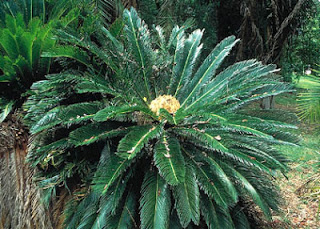 |
The Sago Palm isn?t a palm, but is one of the most primitive plants that reproduces with seeds. It presents a problem to pet owners because every part is toxic to pets, but it tastes good to them. They don?t know not to eat it; then they bleed to death. |
And even weirder, not all plants use just this strategy. Cycads (like the sago palm, which isn?t really a palm at all), and gingko biloba plants have sperm cells with flagella, long projections that whip and move them along, hopefully toward an egg cell. They don?t use a tube cell or pollen tube; these plant cells without cell walls swim. Plant cells that move, now there is an exception worth noting! Some more primitive bryophyte plants (liverworts, mosses) also have motile sperm, but the cycads and gingko are the only examples of seed plants with motile cells.
So cell walls aren?t a defining characteristic of plant cells either. Maybe it is the chloroplast that defines a plant cell --- maybe not.
As you can guess, there are exceptions going both ways. There are organisms that have chloroplasts that aren?t plants, namely the algae. But a more interesting exception are many of the protozoan Euglenids. Euglena gracilis is a prototypical euglenid that can produce carbohydrate by photosynthesis. However, most euglenids can also eat things, which makes them both autotrophic and heterotrophic.
As for the other direction, there are many plants that don?t have chloroplasts. Of the roughly 350,000 different species of plants on earth, almost 3000 of them are non-photosynthetic. Therefore, the most common characteristic that people use to tell a plant from a non-plant (photosynthesis by chlorolplasts) isn?t true for almost 1% of the species on Earth. That is a pretty big exception. That would be like saying 1% of people on earth don?t have a brain! O.K., maybe that's a bad example.
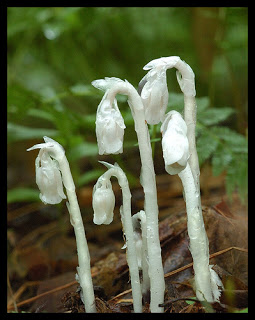 |
Indian Pipe is Monotropa Uniflora. Monotropa means one turn, and uniflora means one flower. The plant is called the ghost plant ? obvious, or the corpse plant ? because it turns black as it matures. This naming thing is easy! |
Indian pipe (Montropa uniflora, or ghost plant) is one such plant. Related to the blueberry of all things, the ghost plant has gone its own way and become parasitic. It garners its nutrients and energy from the tissue of another plant. The roots of the Indian pipe penetrate the rhizoids (root-like projections) of certain types of fungi and sponge off their hard work. In fact, the fungi themselves are symbiotic, having invaded the roots of certain pine tree species.
The fungus and tree live together in a mutualistic relationship, making the fungus a mycorrhizal(myco = fungus and rrhizal = root) variety. The tree supplies the fungus with carbohydrate, and fungus supplies the tree with mineral nutrients. However, Indian pipe does not respect this mutualism and is a parasite of the fungus, taking some of the carbohydrate supplied by the tree. This makes the Indian pipe a myco-heterotrophic parasite.
Other plants without chloroplasts are holoparasitic (gain nutrients only by parasitism). These would include the rafflesia species of the Indonesian rainforests. These plants are know for having the largest single flowers in the world, some the size of car tires! The plant doesn?t have a stem or root or leaf, it is a vine that grows inside another type of vine. Only when it is ready to flower does it bud out from the bark of the host. The flower takes nine moths to develop, and then smells like rotting flesh in order to attract fly pollinators.
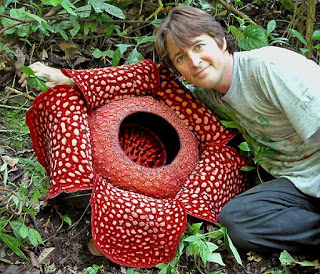 |
Rafflesia is also known as the corpse flower, as opposed to the corpse plant (Indian pipe). This is because it smells like a corpse in order to attract the flies that pollinate it. This young man is either holding his breath, has no sense of smell, or is just really odd. |
In addition to holoparasitic plants, plant cells without chloroplasts would include those same gamete cells we discussed above as not having cell walls. And neither to do most root cells. However, there are exceptions, like many of the orchids. The ghost orchid has photosynthetic roots, which is a good idea, since they grow directly on other plants; their roots are not buried in the dirt.
Maybe it is not a single characteristic that makes a plant cell a plant cell, or a plant a plant. Maybe it is the combination of cells with cell walls, central vacuoles and in most cases, chloroplasts that make it a plant. I guess it is like beauty; you can?t define it, but you know it when you see it.
Next week we will take another shot at finding a defining characteristic of plant cells, namely the plastid, the mother of all chloroplasts ? might there be an exception?
For more information and classroom activities on cell walls or parasitic plants, see:
Cell walls ?
http://www.biology4kids.com/files/cell_wall.html
http://www.scienceprofonline.com/microbiology/bacterial-cell-wall-structure-gram-positive-negative.html
http://library.thinkquest.org/C004535/cell_wall.html
http://www.ccrc.uga.edu/~mao/intro/ouline.htm
http://micro.magnet.fsu.edu/cells/plants/cellwall.html
http://www.cellsalive.com/cells/cellwall.htm
http://faculty.ccbcmd.edu/courses/bio141/lecguide/unit1/prostruct/cw.html
http://employees.csbsju.edu/ssaupe/biol327/lecture/cell-wall.htm
http://www.biologie.uni-hamburg.de/b-online/e26/26.htm
http://www.answers.com/topic/how-does-a-primary-cell-wall-differ-from-a-secondary-cell-wall
www.umsl.edu/~microbes/introductiontobacteria.pdf
http://www.scienceprofonline.org/microbiology/gram-negative-bacteria-cell-wall.html
http://tami-port.suite101.com/how-do-antibiotics-work-to-kill-bacteria-a74616
Parasitic plants -
http://waynesword.palomar.edu/plnov99.htm
http://www.botany.org/parasitic_plants/Hydnora_africana.php
http://www.teachervision.fen.com/dk/science/encyclopedia/parasitic-plants.html
http://www.bbc.co.uk/learningzone/clips/parasitic-plant/12796.html
http://www.ehow.com/info_8575832_two-rain-forest-illustrate-parasitism.html
http://www.moreheadplanetarium.org/index.cfm?fuseaction=page&filename=science360_flowerpower_videouse.html&print=1
http://www.montgomeryadvertiser.com/article/20120427/LIFESTYLE/304270006/Parasitic-field-dodder-very-hard-control
http://www.parasiticplants.siu.edu/
http://parasiticplants.blogspot.com/
http://www.apsnet.org/edcenter/intropp/pathogengroups/pages/parasiticplants.aspx
http://www.forestpathology.org/mistle.html
http://www.gardenbuildingsdirect.co.uk/Article/parasitic-plants
- Prokaryotes Vs Eukaryotes
While eukaryotic cells and prokaryotic cells have some characteristics in common, they diverged from their common ancestor billions of years ago, thus accounting for significant differences in overall structure and function. Here we will go over them....
- Eukaryotic And Prokaryotic Cells
What are Eukaryotic and Prokaryotic cells??? They are the tiny little building blocks of life and sometimes death! Eukaryotic cells are what make up humans, animals, and plants. They do everything from constructing us as babies with DNA to making...
- Cellulose
The cells of a plant are surrounded by a thick protective layer called the cell wall. Cellulose is a major component of this protective layer. Cellulose is a polysaccharide, a polymer of glucose, (carbohydrate) and it is the most abundant macromolecule...
- #2.1. Cell Structure - Syllabus 2015
? The microscope in cell studies ? Cells as the basic units of living organisms ? Detailed structure of typical animal and plant cells, as seen using the electron microscope ? Outline functions of organelles in plant and animal cells ? Characteristics...
- Some Living Descriptions
Protista- unicellular eukaryotes, some multicelled formscell sturcture simple to very complexsome heterotrophs- protozoanssome autotrophs- algaeasexual repro, some both sexual, asexualmotile, non-motile, sizes- most microscopic but some may be 100m in...
